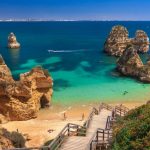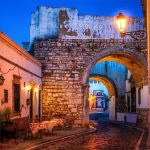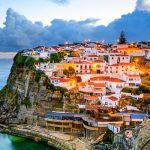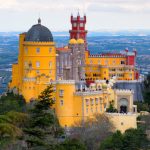Festivals pack Portugal’s calendar. Drink, dance and feast your way through all-night revelries such as Lisbon’s Festa de Santo António or Porto’s Festa de São João. There are kick-up-your-heels country fairs in the hinterlands, and rock and world-music fests all along the coast. Any time of year is right to hear the mournful music of fado in the Alfama, join the dance party in Bairro Alto or hit the bars in Porto, Coimbra and Lagos. Rural Portugal has its own age-old musical traditions, from the polyphonic cante Alentejana in the Alentejo to the pauliteiros (stick dancers) of Miranda do Douro.
Money
The official currency in Portugal is the Euro. While credit and debit cards are generally accepted, Portugal is a cash-centric country — especially when you get outside of cities like Lisbon and Porto. Like other EU countries, Portugal has ATMs throughout the country. You’ll see them at the airport, banks, and along the streets of the cities. Smaller towns will have at least a couple of ATMs, as well. Depending on your bank and your home country, you might never see a familiar ATM in Portugal. But never fear; you’ve got options that will work like any ATM back home. Just look for Multibanco ATMs — on the street or in any Portuguese bank — and you’ll do fine. The standard ATM limit in Portugal is generally €400 per day. But be prepared – your ATM might limit you to €200 per withdrawal. If so, try making a second withdrawal, even at the same machine, to get to the €400 limit.
Eating and Drinking
Portugal has a huge range of eating options, and booking on the day of your meal is usually fine. Aim to book top-end restaurants a few weeks in advance.
- Restaurante Portugal’s restaurants range from basic to high-end and typically open only for lunch and dinner.
- Adega The ‘wine cellar’ usually has great ambience and serves traditional dishes plus good inexpensive wines (often straight from the cask).
- Cafe Open during the day and typically serves snacks, sandwiches, coffees and desserts.
- Pastelaria Specialises in pastries, cakes and croissants.
- Tasca An inexpensive, often family-run eatery that whips up fresh, simple dishes.
Year in Food
In late spring and early summer, you’ll see signs advertising caracois (snails). These little delicacies are cooked in olive oil, garlic and herbs and are quite tasty. They go nicely with a cold beer.
Head to the market for bountiful fruits and vegetables: plump tomatoes, juicy peaches, nísperos (loquats), strawberries and other delights. Sardines, much loved along the coast (especially in Lisbon), are available from May through October, and are generally bigger and juicier in July and August.
In September the Douro Valley begins its annual grape harvest; it’s a festive time to visit and some wineries allow visitors to take part. It’s also the season of pomegranates and persimmons.
During cold days Portuguese hunker down over hearty dishes such as cozido à portuguesa, a dish of mixed roast meats, potatoes, cabbage and carrots. Rich soups like canja (chicken soup) and sopa de peixe (fish soup) are also popular. In the Minho, January to March is the season for tender grilled eels.
Tipping
In Portugal it’s only really the tourist areas such as Lisbon and The Algarve where tipping will be commonplace. If you are staying in a less touristy area there won’t be as much of an expectation for you to tip, in-fact over most of Portugal, the locals tend to only tip for exceptional service. However, it’s unlikely that any tip you offer will be refused and people in the service industry may expect a tip from you if they realize you are a tourist. The amount for the tip can vary between 2 to 5 euros.
Australian Government Travel Advice
The Australian Government provides up to date information on the safety of travelling to various countries, and all travellers should take note of this advice. Liberty Tours recommends that all travellers take out appropriate Travel Insurance to cover the entire duration of their absence from home.
https://www.smartraveller.gov.au/destinations/europe/portugal
Follow this link for current official assessment:
Advice on health risks and vaccination recommendations can also be found using the same link.
Weather
The climate of Portugal is temperate and influenced by the Atlantic Ocean. In the north, the climate is cool and rainy, while moving south it becomes gradually warmer and sunnier; in the far south, the region of Algarve has a dry and sunny microclimate. In the interior, on the border with Spain, the climate is a bit more continental.
In summer, Portugal is protected by the Azores High, so it’s usually sunny everywhere, however, a few weather fronts can still affect the northern part of the country. In the rest of the year, and especially from November to March, rainfall can occur, especially in the north where it is more frequent and abundant. Therefore, the landscape in the north is definitely green, while it gradually becomes more arid towards the south, down to Algarve, which has a fairly dry climate.Winter, from December to February, is mild on the coast, even in the northern part, since the average temperature in January is around 9 °C (48 °F) in Porto, 11 °C (52 °F) in Lisbon, and 12 °C (53.5 °F) in Faro.
In winter, there are periods of good weather when the Azores Anticyclone settles in the country, but there are also waves of bad weather, with rain and wind. Sometimes, gale force winds may blow from the ocean, especially in the north.
What to pack
In winter: for Lisbon and the south coast, bring spring/autumn clothes, a sweater, a coat, a rain jacket; you can bring a jacket a bit heavier and a hat for Porto and the northern coast. For inland and mountainous areas: warm clothes, such as a down jacket, a hat, a raincoat or umbrella.
In summer: bring light clothes, a sun hat, a light scarf for the sea breeze, a sweatshirt for the evening; a sweatshirt and a light jacket for the north and the mountains.






